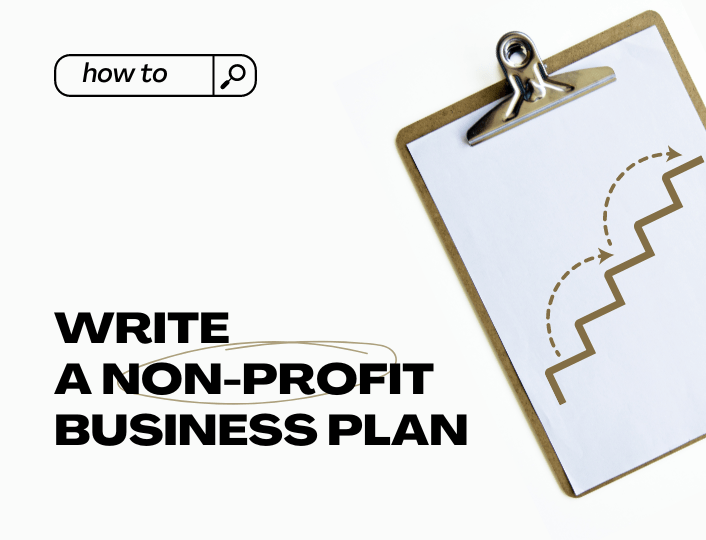So you’re starting a non-profit business but haven’t sat down to craft a business plan?
Many entrepreneurs venture into non-profit with a truckload of impactful ideas they intend to achieve. Along the way these ideas begin to wither away due to poor planning and execution.
To manage and grow a non-profit business, you must outline your strategies, goals and objectives. A clear, non-profit business plan is the first of many steps to getting this done.
What is a Non-Profit Business Plan?
A non-profit business plan is a strategic document outlining the mission, objectives, operational structure and financial projection of an organization.
It serves as a blueprint for achieving the organization’s goals, guiding the decision-making processes, and showcasing its viability to stakeholders, donors, and grant-making entities.
Whether launching a new non-profit business or seeking to strengthen an existing one, having a comprehensive plan is fundamental to your success.
Why Write a Non-Profit Plan?
A non-profit business plan differs from a for-profit business plan in that a for-profit business plan also clarifies how a business will grow in the market and in revenue.
Beyond securing funding, a well-written non-profit business plan offers several benefits:
- Clarity and Focus – The plan is a roadmap for movement and aligning everyone to the business’s missions and goals.
- Strategic Decision-Making – It helps you make informed decisions about resource allocation, program development, and fundraising strategies.
- Improved Communication – It serves as a communication tool, showcasing your organization’s credibility and professionalism to potential donors, partners and volunteers.
- Impactful Measurement – It establishes benchmarks for measuring your impact and demonstrating the effectiveness of your programs.
- Organizational Growth – It lays the foundation for sustainable growth and expansion, enabling you to reach more people and make a greater impact.
Crafting Your Non-Profit Business Plan
Every non-profit business plan has specified components attached to it that describe your business and what you do. Below are some components:
Executive Summary
The executive summary is a concise overview of your organization. It usually appears first in the business plan, however, it’s often the last thing you write because it encapsulates the essence of the entire document.
A good summary should include in brief the mission of your business, its key objectives, target audience and a summary of your financial projections. It needs to be well-structured such that it is easily comprehensible to anyone who reads it. Writing a poor summary negatively affects your business and its reputation around sponsors.
Mission, Vision, and Values
Whether you are a human service, educational, environmental or religious non-profit organization, you should have a clear mission and vision. Let us know why you do what you do and how you intend to positively impact the world.
Define the mission statement that encapsulates your organization’s purpose, followed by a clear vision outlining the future you aim to create. Incorporate the core values that guide your actions and decisions, reflecting the principles on which your non-profit stands.
For example, the Epileptic Foundation a Humanitarian non-profit organization for epileptic people clearly defines their mission statements, visions and core values.


Your mission and vision statements should be boldly and clearly articulated to represent your business and cause.
Organizational Structure and Management
Sponsors, donors and benefactors are more likely to give to nonprofits with organizational structure than those without. This is because a hierarchical structure shows that the business wants to be a business.
Keep this structure as detailed as possible. Include board members, key personnel, and their role in the company. Highlight their qualifications and experiences, emphasizing their relevance to the organization’s mission.
Programs and Services
Every non-profit is created for a cause. This is the same as services or the product of a for-profit business. Let your donors know what you offer by reading your business plan.
In a clear concise manner, describe the programs and services your non-profit offers. Explain how these initiatives align with your mission, their anticipated impact, and how they address the needs of your target beneficiaries or community.
Target Audience and Market Analysis
Identify and analyze your target audience or beneficiaries. Conduct market research to understand the needs, demographics and challenges of your intended community or beneficiaries. Clearly articulate how your programs meet those needs.
Marketing and Fundraising Strategies
As you know your non-profit is solely based on donations and contributions to a cause. This step is crucial to writing a spectacular non-profit business plan. You need to state clearly your marketing and fundraising strategies. These tips need to answer some of the questions like?
- What are your marketing strategies?
- How to create and promote awareness about your non-profit organization?
- How to reach your potential donors, volunteers and stakeholders?
- What social media channels do you use to communicate with your target audience and benefactors?
- What fundraising initiatives and events have you designed to generate revenue for the organization?
- What are the eligibility criteria for potential donors and partners?
Financial Projections and Budget
Show your initial capital, how much you were worth, how much you are worth now and your future financial projection. Distill the reports to a fifth-grade level, such that anyone who picks it up knows the state of things.
Include your income statements, balance sheets, and cash flow statements. Present a clear budget that outlines anticipated expenses and revenue sources, demonstrating fiscal responsibility and sustainability.
Evaluation and Measurement Metrics
Define key performance indicators and metrics to evaluate the success of your programs and initiatives. Establish a framework for regular assessment and adjustment to ensure you’re effectively meeting your goals.
Risk Management and Contingency Plans
Identify potential risks and challenges that could impact your organization’s operations. Develop contingency plans to mitigate these risks, ensuring the continuity of your programs and services.
Tips for Writing a Compelling Non-Profit Business Plan
- Focus on your impact – Clearly articulate the positive change your non-profit is making and the lives you are touching. Use compelling stories and data to showcase your impact.
- Keep it concise and comprehensible – Aim for a clear and concise writing style, avoid jargon and technical terms. Your business plan should be easy for anyone to understand regardless of their background.
- Tailor your plan to your Audience – Adapt your language and content to resonate with specific audiences such as potential donors, grantmakers, or volunteers.
- Be realistic and Data-Driven – Base your plans on realistic assumptions and support your claims with data and research.
- Get Feedback and Revise – Share your draft plan with key stakeholders and incorporate their feedback to refine and improve it.
Conclusion
Remember your non-profit business plan is a living document. It should be regularly reviewed and updated to reflect changes in your organization, the needs of your community and the funding landscape.
By following these tips and resources, you can create a compelling non-profit business plan that will guide your organization towards a sustainable and impactful future.
The world will continue to need difference makers in the form of non-profit organizations. If you’d do the work, you might as well do it with a business plan.




